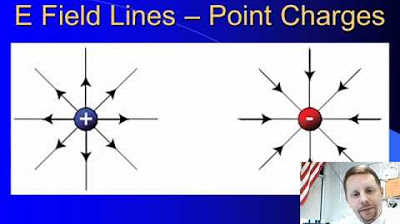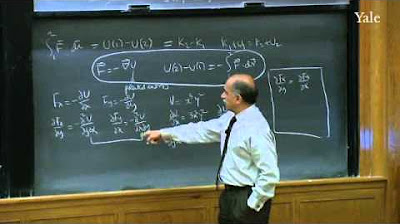Electric Field of a Dipole
TLDRIn this AP Physics essentials video, Mr. Andersen delves into the concept of the electric field of a dipole, contrasting it with the more familiar magnetic dipole. He introduces the electret, an insulating material like wax that becomes polarized and carries a permanent charge when subjected to high voltage, a significant component in electronics such as smartphone microphones. The video script explains the interaction of electric fields using vector addition, a fundamental principle for determining the net electric field around a dipole. Through the use of a phet simulation, viewers can visualize how the electric fields of individual point charges combine to form the electric field pattern of a dipole. The script challenges the audience to apply this knowledge to scenarios involving multiple charges, emphasizing the importance of understanding both the magnitude and direction of vectors for accurate calculations. The video concludes with a practical application, guiding viewers on how to determine the net electric field direction at a point influenced by several charges, and how to quantify it using vector addition principles.
Takeaways
- 🧲 The concept of a dipole in electrostatics is analogous to a magnetic dipole, with an electret serving as a permanent electrostatic magnet.
- 🕒 Electrets were developed in the 1960s and are created by polarizing insulating materials like wax under high voltage while in a liquid state.
- 📱 Electrets are important in electronics, with applications such as in smartphone microphones due to their permanent charge and energy efficiency.
- 🔋 Understanding the electric field of a dipole requires knowledge of vector addition to determine the net electric field at any point around the dipole.
- 📚 The script emphasizes the importance of understanding both magnitude and direction of electric fields, as vectors have both these properties.
- 📐 Vector addition is demonstrated through the tail-to-head or tail-to-tip method to find the resultant electric field from multiple point charges.
- 🌐 The electric field lines around a dipole form a complex pattern that can be mapped out using vector addition of individual point charges.
- 🔬 A phet simulation is used in the video to visually demonstrate the electric field strength around a monopole and how it changes with distance.
- 🔍 The video script provides practical examples of how to calculate the net electric field at a point influenced by multiple charges using vector addition.
- 📈 The inverse square law of the radius is mentioned in relation to the strength of the electric field around a charge.
- 📝 The script concludes with a challenge to distinguish between monopoles and dipoles and to apply vector addition to determine the net electric field at various points.
Q & A
What is an electret?
-An electret is a type of insulating material that has been given a permanent electric charge. It was developed in the 1960s and is used in electronics, such as in smartphone microphones, because it does not require any energy to maintain its charge.
How are electrets created?
-Electrets are created by melting an insulating material, like wax, into a liquid state and then applying a high voltage to it. As the material solidifies, the atoms become polarized, resulting in a solid permanent electret with a permanent charge.
What is the difference between an electric monopole and a dipole?
-An electric monopole is a single point charge or a sphere that has an electric field radiating from it if it's positive, or converging towards it if it's negative. A dipole, on the other hand, is formed when two equal and opposite charges are brought close together, creating a system with a net electric field that can be determined through vector addition.
How is the net electric field around a dipole determined?
-The net electric field around a dipole is determined by performing vector addition of the individual electric fields created by the positive and negative charges that make up the dipole. This allows for the calculation of the net electric field at any point in space around the dipole.
Why is vector addition important for understanding electric fields?
-Vector addition is important for understanding electric fields because it allows us to determine the net electric field at a point where multiple electric fields interact. It takes into account both the magnitude and direction of the individual electric fields to find their combined effect.
What is the significance of the electric field map of a dipole?
-The electric field map of a dipole provides a visual representation of the electric field's direction and strength at various points around the dipole. This map is crucial for understanding the behavior of the electric field and how it changes with distance and position relative to the dipole.
How does the phet simulation demonstrate the electric field of a dipole?
-The phet simulation demonstrates the electric field of a dipole by allowing users to place a positive charge and then a negative charge in proximity to each other, creating a dipole. The simulation then shows the individual electric fields and allows for vector addition to determine the net electric field at various points around the dipole.
What is the relationship between the electric field strength and the distance from a charge in a monopole?
-The electric field strength from a monopole, such as a point charge or a sphere, is inversely proportional to the square of the distance from the charge. This means that as you move farther away from the charge, the electric field strength decreases.
How does the presence of multiple charges affect the net electric field at a point?
-The presence of multiple charges affects the net electric field at a point by requiring the use of vector addition to determine the combined effect of all the individual electric fields. The magnitude and direction of the net electric field will depend on the relative strengths and orientations of the individual fields.
What is the formula used to calculate the magnitude of the net electric field when two equal electric fields are acting at a point?
-When two equal electric fields are acting at a point, the formula used to calculate the magnitude of the net electric field is the Pythagorean theorem: A^2 + B^2 = C^2, where A and B are the magnitudes of the individual electric fields and C is the magnitude of the net electric field.
How can one determine the direction of the net electric field created by multiple charges?
-The direction of the net electric field created by multiple charges is determined by the vector addition of the individual electric fields. The resultant vector, after adding the vectors tail-to-tip, points in the direction of the net electric field.
What is the practical application of understanding the electric field of a dipole?
-Understanding the electric field of a dipole has practical applications in various electronic devices, such as microphones in smartphones, where electrets are used to maintain a permanent charge without the need for external power. This knowledge also aids in the design and analysis of electric field behavior in other electronic components and systems.
Outlines
🔋 Introduction to Electrostatic Dipoles and Electrets
In this introductory segment, Mr. Andersen discusses the concept of an electrostatic dipole, drawing an analogy with magnetic dipoles. He introduces the term 'electret,' which is an insulating material that becomes permanently polarized through a process involving melting and high voltage application, resulting in a permanent charge. Electrets are highlighted as important components in electronics, especially in microphones of smartphones due to their energy efficiency. The video script then transitions into the main topic of electric fields, specifically around dipoles, and emphasizes the importance of understanding vector addition to determine the net electric field at various points around a dipole.
📚 Understanding Electric Fields and Vector Addition
This paragraph delves deeper into the concept of electric fields, starting with the basics of monopoles and moving on to the more complex scenario of dipoles. Mr. Andersen explains how electric field lines emanate from positive charges and converge towards negative charges. He then illustrates the process of combining electric fields from two charges to form a dipole, using vector addition to determine the net electric field at different points around the dipole. The explanation includes a step-by-step guide on how to perform vector addition, which is crucial for visualizing and calculating the resultant electric field. The segment also introduces a phet simulation tool to demonstrate the concept practically, showing how the electric field strength decreases with distance and how the fields from individual charges combine to form the electric field of a dipole.
Mindmap
Keywords
💡Electric Field
💡Dipole
💡Electret
💡Vector Addition
💡Magnetic Dipole
💡Polarization
💡Smartphone Microphone
💡Monopole
💡Phet Simulation
💡Inverse Square Law
💡Magnitude
Highlights
Introduction to the electric field of a dipole.
Comparison between magnetic dipoles and electrets in electrostatics.
Historical development of electrets in the 1960s.
Creation of electrets using insulating materials and high voltage.
Permanent charge in electrets and their importance in electronics.
Use of electrets in smartphone microphones for energy efficiency.
Explanation of monopoles and their electric field lines.
Concept of bringing two charges together to create a dipole.
Importance of vector addition in understanding the electric field of a dipole.
Visual representation of electric field vectors around a dipole.
Understanding vector properties: magnitude and direction.
Demonstration of vector addition with electric fields.
Complex scenarios with multiple electric fields acting on a point.
Introduction to the phet simulation for visualizing electric fields.
Application of vector addition to calculate the net electric field.
Practical example of calculating net electric field with multiple charges.
Quantitative approach to vector addition using Pythagorean theorem.
Distinguishing between monopoles and dipoles in electric fields.
Teaching the use of vector addition for determining net electric field magnitude.
Transcripts
5.0 / 5 (0 votes)
Thanks for rating:





